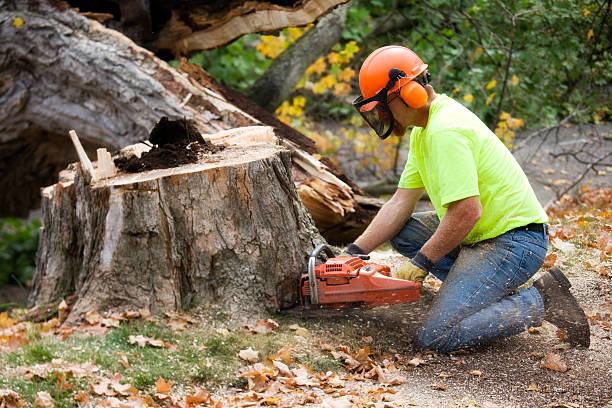Are you left with an unsightly hole in your yard after having a stump ground down? Don’t worry. Filling that hole is easier than you might think! In this article, we will guide you through the process of filling the hole after stump grinding, ensuring a smooth and seamless restoration of your yard.
Firstly, it’s important to understand the significance of filling the hole. Leaving it as is poses a safety hazard and can lead to other issues such as erosion or the formation of puddles. By filling the hole, you not only restore the aesthetic appeal of your yard but also prevent any potential damage to your property. So, let’s get started on how to properly fill and restore that hole!
To begin, you’ll need to prepare the hole for filling. Start by removing any debris or loose dirt from the hole using a shovel or rake. Next, ensure that the hole is free from any large rocks or roots that may obstruct the filling process. Once the hole is cleared, it’s time to gather the necessary materials for filling, such as topsoil or a mixture of soil and compost. In the next section, we will guide you step by step on how to properly fill and restore the hole, ensuring a seamless finish to your yard. So, let’s dive in and get that hole filled!
Understanding the Importance of Filling the Hole
You’ll need to make sure you fill the hole after stump grinding to prevent any accidents or injuries. There are several benefits of filling the hole after stump grinding. Firstly, filling the hole ensures a safer environment for everyone. Without filling the hole, it can become a tripping hazard, especially for children or pets playing in the area. By filling the hole, you eliminate this risk and create a smooth and even surface.
Secondly, filling the hole after stump grinding helps to maintain the aesthetics of your yard. An unfilled hole can be an eyesore and disrupt the overall appearance of your outdoor space. Using the right materials to fill the hole, you can seamlessly blend it in with the surrounding area, making it look neat and well-maintained. This is especially important if you have a well-manicured lawn or garden that you take pride in.
When it comes to the best materials for filling stump grinding holes, there are a few options to consider. One popular choice is topsoil, as it provides stability and promotes healthy plant growth. Another option is a mixture of topsoil and compost, which fills the hole and enriches the soil. Additionally, you can use sand or gravel to fill the hole, which provides a firm and compact surface. Ultimately, the choice of materials depends on your specific needs and preferences, as well as the condition of your soil.
Remember, filling the hole after stump grinding is crucial for safety and aesthetics. Using the right materials, you can create a smooth and even surface that enhances the overall look of your yard. Consider the benefits and choose the best filling material that suits your needs, ensuring a well-maintained and hazard-free outdoor space.
Preparing the Hole for Filling
Once the stump has been completely removed, it’s important to properly prepare the void left behind to ensure a seamless and aesthetically pleasing result. Start by using soil compaction techniques to create a firm foundation for the fill material. This involves using a compactor or tamper to compact the soil in and around the hole. By compacting the soil, you prevent future settling and sinking of the fill material.
Next, it’s crucial to choose the right fill material for the hole. The material should be able to withstand weather conditions and provide stability. Common fill materials include topsoil, sand, or a mixture of soil and compost. Topsoil is often the preferred choice as it provides a fertile base for new vegetation to grow. Make sure to choose a fill material that matches the surrounding area and blends in seamlessly.
Once you have chosen the fill material, carefully spread it evenly throughout the hole. Use a rake or shovel to level the fill material and ensure it is flush with the surrounding ground. Pay attention to any low spots or uneven areas and adjust the fill material accordingly. It’s important to take your time during this step to achieve a smooth and level finish. By following these steps and using proper soil compaction techniques and the right fill material, you can successfully prepare the hole for filling and achieve a seamless and aesthetically pleasing result.
Filling and Restoring the Hole
After the stump has been completely removed, the process of restoring the hole begins, bringing a sense of satisfaction and renewal to the once barren landscape. The first step in filling the hole is choosing the right fill material. It is important to select a material that is suitable for the specific conditions of your landscape. For example, if the hole is in an area with poor drainage, you may want to choose a fill material that is more porous and allows water to flow through easily. On the other hand, if the hole is in an area with good drainage, a denser fill material may be more appropriate.
Once you have chosen the right fill material, the next step is to ensure proper compaction. This is crucial to prevent the settling and sinking of the filled hole over time. To achieve proper compaction, use a compactor or a tamper to firmly pack the fill material into the hole. Start by adding a layer of fill material and compact it using the compactor. Continue this process, adding layers and compacting them until the hole is completely filled. Be sure to pay extra attention to the edges of the hole to ensure they are properly compacted as well.
Proper compaction also helps to create a level and even surface. After filling and compacting the hole, use a rake or a shovel to smooth out the surface of the fill material. This will help to blend it with the surrounding landscape and create a seamless appearance. Take your time and make sure the surface is even and free of any bumps or indentations. Once you are satisfied with the result, you can move on to other landscaping tasks or simply enjoy the renewed beauty of your landscape.

